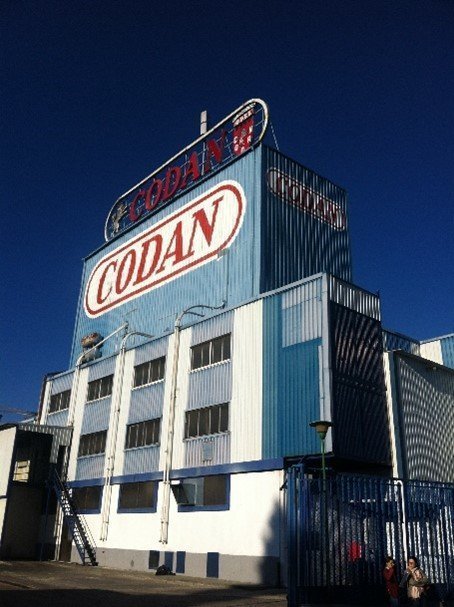Living: Innovation action plan
1. CRFS vision 2030 and challenge statements
Region: A great variety of industries have settled in Arganda, which has one of the most important industrial areas in all of Spain, with fifteen industrial areas (more than 3500 companies and around 30.000 employees).
Vision: Industry digitalization is paramount.
Challenges: 
-
Challenge #1: Monitoring of relevant environment parameters of food production processes. The CODAN company, which operates the food processing factory, is currently transforming the factory from a traditional model to a Smart Factory model. CODAN is going to operate the systems in order to improve the performance of the factory, exploiting the data gathered during the food processing
 activities.
activities.
- Challenge #2: Facilitating food transparency in supply chain. It is intended to explore possibilities to incorporate into the product information, relevant data on production, such as the origin of the main foods or a carbon footprint calculation.
2. Collaboration with stakeholders
Build capacity on systems thinking and participate in appropriate training and events organised by Cities2030: Participation in Lab-to-Lab meetings by LL owner (UPM). Participation in LL – reflection session for T5.2. Participation and moderation of T5.2 – Wrap-Up sessions (27.4.2022).
Carry out Systems Thinking/Capacity building Workshops (STW) with local stakeholders:
Consumer workshop: The target groups invited to this workshop are regular consumers, either technology or food products. The objective is to obtain feedback on the general public’s perception of the innovations proposed in the Arganda lab. These workshops will be held mainly at the UPM facilities. Consumer workshops have been carried out where systems thinking has been explained and some questions have been asked to food consumers in Madrid (Spain): 20 April 2022. A questionnaire was provided and consumers received a gift (pastry product) for answering the questionnaire. 55 responses were collected.
Expert workshop: The target groups invited to this type of workshop are professionals from one of the food system links, who are used to dealing with food production systems, traceability, waste management, packaging, labelling, among others. The objective of this type of workshop is to obtain a more detailed opinion on some specific aspect of the proposed innovations, so that they can improve day-to-day work in these food systems. An example may be presenting factory workers with a new application that manages incidents that may occur in the manufacturing process, in order to obtain recommendations to improve this application and adapt it to real food production scenarios. These workshops will be held mainly in expert’s facilities. One expert workshop was held the 8th of July 2021 in a processing company facility (Arganda municipality) where experts in food processing exchanged ideas of how technology can help process automation in Industry 4.0.
3. Living Lab resources

In addition to the manager of this Living Lab (UPM), there are also other companies in the field of food systems that have collaborated and continue to collaborate with UPM in research projects and innovation activities. Some of these companies are Harinera Arandina S.A. (located in Aranda del Duero, Spain) and Codan S.A. (located in Arganda, Spain). In this section, we will focus on the resources available by the lab in relation to the company Codan with which agreements can be reached for the implementation of solutions developed in Cities2030. Codan is one of the leading manufacturers in the pastry and bakery Spanish industry.
4. Living Lab experiments
Experiment#1: Evaluates if the Quality-of-Experience (QoE) of customers when buying bakery products increases if mobile applications are employed to enhance the shopping experience. An experiment is based on the monitoring of working conditions of workers in a food production company. Gas emissions, temperature and humidity will be measured in real-time and represented in a dashboard. S2CP components will be used. A stakeholder’s workshop will be done where factory workers evaluate the feasibility of the solution.
Experiment#2: Focuses on analysing if the users’ satisfaction and QoE increases if customers are provided with trustworthy and transparent information about the bakery value chain, suppliers and products. The second experiment is based on the development of a marketplace, enhancing the process of dealing with providers and offering a more efficient approach in obtaining supply chain information, increasing final information associated with a product.
Experiment#3: Focuses on improving the production efficiency and workers wellbeing through an Industry 4.0 sensing platform. Continuous and automatic monitoring should help companies reduce resource consumption, waste, and improve the wellbeing and working conditions.
5. Other Living Lab's measures
The Living Lab does not have any other measures apart from experiments.
6. SMART Goals
Specific Goals to achieve, related to Challenge #1. Monitoring of relevant environment parameters of food production processes:
- GOAL#1: Indicator: Thermal discomfort reduction. Types: Productivity, behaviour, gender equity. Target value: Reduction in unitary annual number of thermal discomfort episodes in 10%.
- GOAL#2: Indicator: Real-time alert notification. Types: Productivity, delivery and time. Target value: Generation of alerts related to real time information in less than 30 seconds since error detection.
Specific Goals to achieve, related to Challenge #2. Facilitating food transparency in supply chain:
- GOAL#3: Indicator: Improvement of user satisfaction. Types: Quality. Target value: Improvement in users’ satisfaction and QoE (global, trustworthy and transparent information): Significant at p < 0.005.
- GOAL#4: Indicator: Increase in supply chain information. Types: Quality, Productivity. Target value: Increase in the quantity of supply chain information per specific product by 10%
7. Communication, dissemination and exploitation
The communication strategy goes through the promotion of the activities carried out in the lab so that these practices are accessible and replicable by other Labs and other CRFS actors. The following list of communication actions is established:
- Publication of events and results on the Cities2030 Community platform: https://cities2030-community.gisai.eu/labs/page/5-welcome-page/.
- Continuous update of the general information of the Lab on the official website of Cities2030: https://cities2030.eu/crfs-lab/arganda-lab/.
- Publication of Good Practices in S2CP Good practices tool: http://good-practices.gisai.geoide.upm.es/.
- Generation of audiovisual material in the form of videos with the results of the experiments. As an example, you can see previously created material for similar research projects: https://www.youtube.com/watch?v=__jj9AKWRaU.
The dissemination strategy goes through the publication of results in appropriate forums. Since the innovations that will occur in the Arganda Lab are related to the use of technological tools to improve processes in the field of food production, the forums that have been chosen for the communication of results are technological forums. A study has been made of the main congresses that would be suitable for the dissemination of results, given the theme of technological innovations within the field of food systems. The congresses selected to make these contributions are listed below: (1) ICITS – International Conference on Information Technology & Systems. ICITS is an international forum for researchers and practitioners to present and discuss the most recent innovations, trends, results, experiences and concerns in the several perspectives of Information Technology & Systems. The conference is held annually and the lab managers have experience in publishing articles on technological innovations in food systems, so they know that this topic is within the scope of the conference. (2) CISTI – Iberian Conference on Information Systems and Technologies. CISTI is a technical and scientific event, whose purpose is to present and discuss knowledge, new perspectives, experiences and innovations in the Information Systems and Technologies field. Accepted papers in CISTI'2022 will be submitted for inclusion into IEEE Xplore Digital Library and will be submitted for indexing in ISI, Scopus, EI, INSPEC and Google Scholar. The conference is held annually and the lab managers have experience in publishing articles on technological innovations in food systems, so they know that this topic is within the scope of the conference.
The exploitation strategy considers the profitability of the assets generated in the project to provide additional value to the work carried out, and that supposes a benefit for the Labs owners or the lab facilitators. In this case, the decided exploitation strategy goes through the registration of the intellectual property of the generated assets, without having yet decided on the type of use licence for these assets. Arganda Lab participants have previous experience in software registration through the organisation to which they belong, UPM. The UPM has an Intellectual and Industrial Property Unit, which is in charge of protecting the research results generated by the university community to favour their transfer to the productive sector. Among its functions are patent management, advice on matters related to intellectual and industrial property, registration of intellectual property works of a technical nature (computer programs, databases, multimedia works), institutional brand management and training on intellectual and industrial property.
8. Continuity- and scale-up measures
It is considered a priority to establish a set of decisions and actions that guarantee the support of continuity and scale-up of the Lab activities after the Cities2030 project time frame.
Some of the actions have been implemented: The useful life of the Initial infrastructure investment to support the technological deployments of the project is greater than the Cities2030 project timeframe. Some cloud hosting servers and sensor devices that have already been financed will continue to function beyond Cities2030, so it is not necessary to make new investments in equipment the first years after the project. Web access to the resources is also covered on a short-term basis through long-term domain registration and prepaid SSL security certificates.
In order to sustain the infrastructure beyond the project, new financing proposals for projects with objectives similar to Cities2030 will be used, to give continuity to the actions undertaken in these months, and private financing mechanisms will also be used by the companies of the food systems and those that are part of the Living Lab, which will see the benefit of applying these innovations to their production processes recognized.
9. Risk assessment
A risk analysis is carried out considering for each risk the properties of Probability (How often will a certain risk lead to an accident?) and Severity (When that risk does cause an accident, how severe will the outcome be?), as Low, Medium or High. For each risk we provide a description (D), an analysis of the cause of the problem (C) and which would be the mitigation measures (M) to reduce Probability or Severity.
|
Risk description (D) / Cause of the problem (C) / Mitigation measures (M) |
Severity |
Probability |
|
(D) Conflict of interest between the conclusions and the business of the partners. (C) Desire of the partners to obtain good results of the analysis and to be reinforced. (M) Duplicate work because some partners want to draw their own conclusions. |
M |
M |
|
(D) Prejudices when analysing the data. (C) Vision of the problems of a CRFS only through the vision of a stakeholder. (M) Working with the client to explain a more objective view to the partner outside of their perspective. |
L |
L |
|
(D) Lack of information at the regional and city level. Usually only aggregate data is available. (C) The organisations that generate statistics are at the autonomous community or national level. (M) Additional research to try to disaggregate the information obtained initially. |
H |
M |
|
(D) Problems involving end users, due to reluctance to participate in the Living Lab. (C) Lack of incentives for end users to participate. (M) Additional work alone to cover, through alternative sources of information, the data that the stakeholders did not provide. |
H |
M |



 activities.
activities.